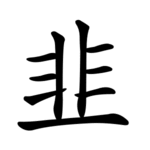Radical 179
| 韭 | |
|---|---|
| Radical 179 (U+2FB2) | |
| 韭 (U+97ED) "leek" | |
| Pinyin: | jiǔ |
| Bopomofo: | ㄐㄧㄡ |
| Wade–Giles: | chiu3 |
| Jyutping: | gau2 |
| Cantonese Yale: | gau2 |
| Hiragana: | キュウ, にら kyū, nira |
| Kanji: | 韭 nira |
| Hangul: | 부추 buchu |
| Sino-Korean: | 구 gu |
| Stroke order animation | |
 | |
Radical 179 meaning "leek" is 1 of 11 Kangxi radicals (214 radicals total) composed of 9 strokes.[1]
In the Kangxi Dictionary there are 20 characters (out of 49,030) to be found under this radical.
Characters with Radical 179
| strokes | character |
|---|---|
| without additional strokes | 韭 |
| 6 additional strokes | 韯 |
| 7 additional strokes | 韰 |
| 8 additional strokes | 韱 |
| 10 additional strokes | 韲 |
Literature
- Fazzioli, Edoardo (1987). Chinese calligraphy : from pictograph to ideogram : the history of 214 essential Chinese/Japanese characters. calligraphy by Rebecca Hon Ko. New York: Abbeville Press. ISBN 0-89659-774-1.
- Lunde, Ken (Jan 5, 2009). "Appendix J: Japanese Character Sets" (PDF). CJKV Information Processing: Chinese, Japanese, Korean & Vietnamese Computing (Second ed.). Sebastopol, Calif.: O'Reilly Media. ISBN 978-0-596-51447-1.
References
- ↑ "Unihan data for U+97ED". Unicode Consortium. Retrieved 1 April 2011.
| Wikimedia Commons has media related to Radical 179. |
This article is issued from Wikipedia - version of the 9/12/2015. The text is available under the Creative Commons Attribution/Share Alike but additional terms may apply for the media files.